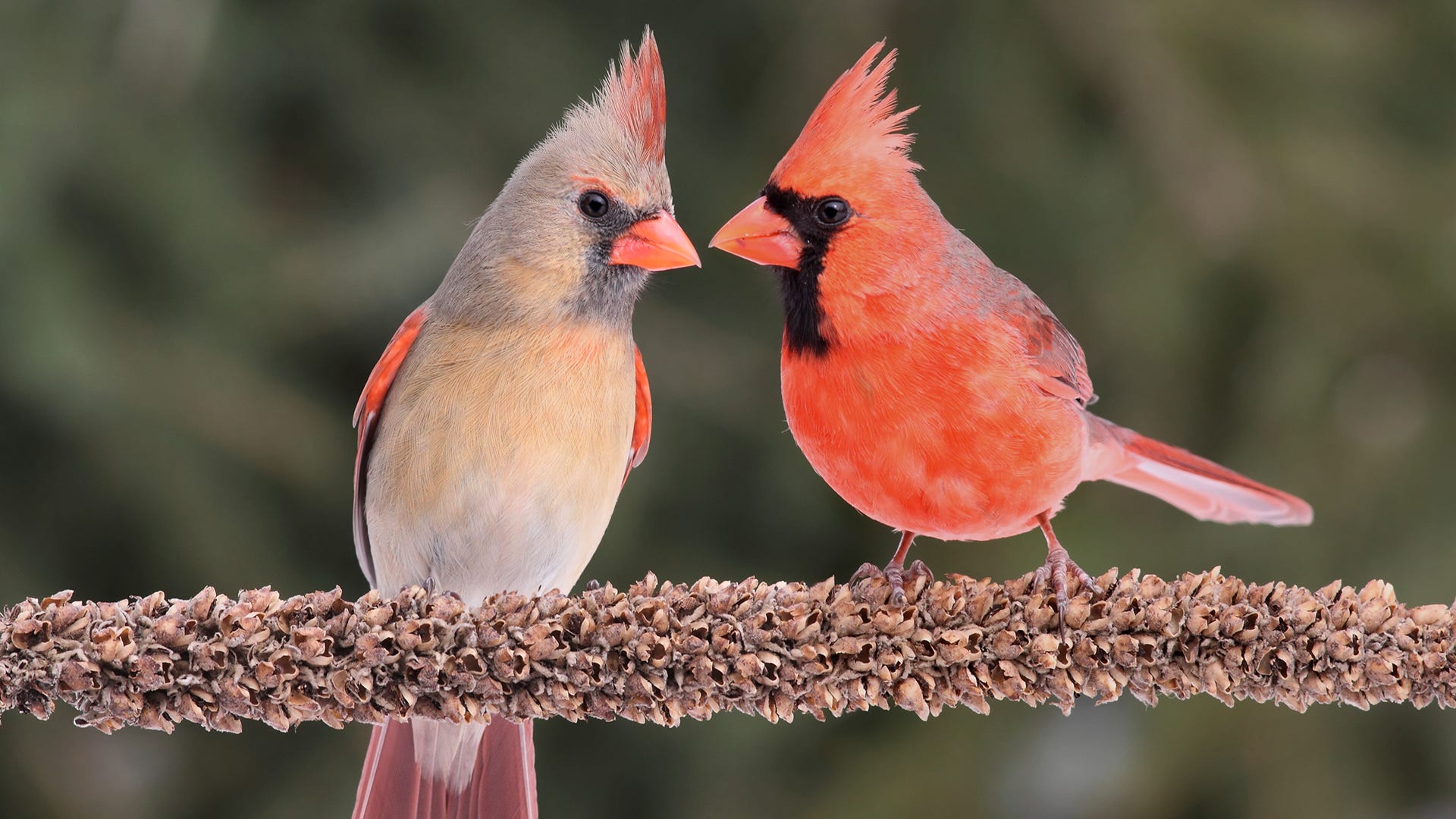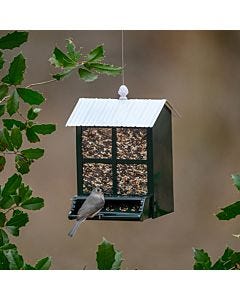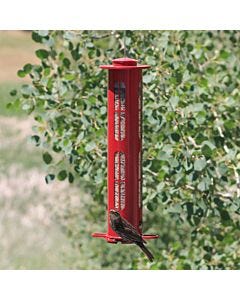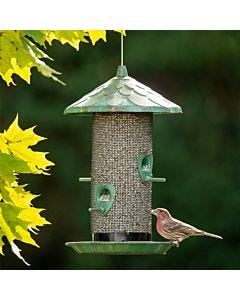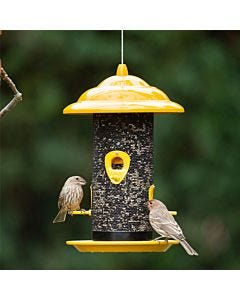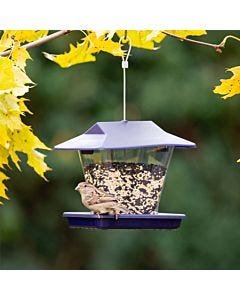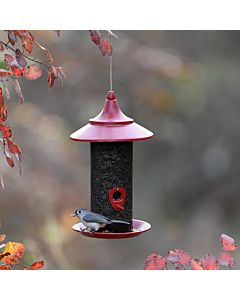Northern Cardinals are probably the most desired of all backyard-visiting birds. With their vibrant plumage and beautiful songs, it’s no wonder people want to attract Cardinals to their yards.
Luckily for bird lovers, Cardinals are not particularly hard to please. With a few simple alterations to your backyard and birdfeeder set up, your yard could soon become a haven for these beloved birds.
SHOP CARDINAL FEEDERS
Are Cardinals in My Area?

Northern Cardinals are non-migratory birds, meaning that once you draw them to your yard they are likely to stay there year-round. This also means, however, that if Cardinals aren’t native to your area, you won’t be able to do anything to attract them to your yard.
Cardinals can be found in the north as far as Maine and parts of southern Canada. In the south, they extend through Central America and the Gulf Coast. They are native to the west as far as South Dakota and Texas. In addition to their native regions, Cardinals have been introduced to Hawaii, southwestern California, and Bermuda.
7 Tips to Attract Cardinals
As with all living things, Cardinals need food, water, and shelter to survive. By meeting all of these needs and appealing to Cardinals’ specific preferences for each, you can make your backyard a favorite habitat.
1. Choose the Right Food
The first step to attracting any bird is to supply them with the food they enjoy. Northern Cardinals feature a strong, thick beak, which is perfect for large seeds and other hearty foods. Safflower seeds, black oil sunflower seeds, and white milo are among a Northern Cardinal’s favorite seed options. In addition to large seeds, Cardinals enjoy eating crushed peanuts, cracked corn, and berries. During the winter, small chunks of suet are another great choice. Be sure to check regularly that your feeders are filled, particularly during the early morning and late evening when Cardinals prefer to eat. Once Cardinals realize that your backyard offers a year-round, reliable food source, they will likely take up a permanent residence.
2. Use Proper Feeders
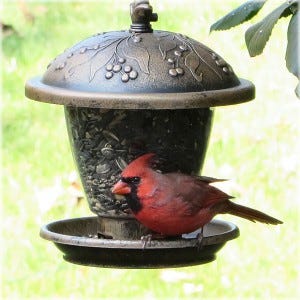 In conjunction with the type of food you offer, you need to select the proper types of feeders to suit your Cardinal friends. Your feeders need to be sturdy enough to support the birds. the weight of a Cardinal is approximately equal to 9 U.S. nickels (1.5 ounces), which is actually on the heavy side for a feeder bird. In fact, lightweight, hanging feeders are best avoided because they may sway under a Cardinal’s weight. Platform feeders and bird feeders with built-in trays that provide enough space to perch are usually preferred. Cardinals are broader, full-breasted birds, so they require more space when visiting a feeder.
In conjunction with the type of food you offer, you need to select the proper types of feeders to suit your Cardinal friends. Your feeders need to be sturdy enough to support the birds. the weight of a Cardinal is approximately equal to 9 U.S. nickels (1.5 ounces), which is actually on the heavy side for a feeder bird. In fact, lightweight, hanging feeders are best avoided because they may sway under a Cardinal’s weight. Platform feeders and bird feeders with built-in trays that provide enough space to perch are usually preferred. Cardinals are broader, full-breasted birds, so they require more space when visiting a feeder.
Shop Perky-Pet® Hopper Feeders »
3. Consider Food Placement
Choosing the ideal placement for your offerings is the last important factor of appealing to your Cardinals’ eating habits. Because Northern Cardinals prefer to have protective cover when feeding, you should place food sources near trees and shrubbery in your backyard. They will enjoy the foliage and feel safer with these hiding spots nearby. If squirrels aren’t a problem in your yard, you can also scatter seed on the ground for the shyest Cardinals to enjoy.
4. Provide Water Sources
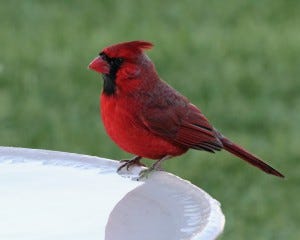 Cardinals need easy access to water for both drinking and bathing. Providing birdbaths or bird waterers is the perfect way to satisfy this need. As with the feeders, a birdbath needs to accommodate the size of these larger birds. Baths with a depth of 2 to 3 inches at the deepest point are usually best. To attract Cardinals to your birdbaths, you may consider adding drippers to keep the water moving. Keep in mind, whichever method you choose, water should be changed, and vessels should be cleaned frequently to prevent algae and dirt buildup.
Cardinals need easy access to water for both drinking and bathing. Providing birdbaths or bird waterers is the perfect way to satisfy this need. As with the feeders, a birdbath needs to accommodate the size of these larger birds. Baths with a depth of 2 to 3 inches at the deepest point are usually best. To attract Cardinals to your birdbaths, you may consider adding drippers to keep the water moving. Keep in mind, whichever method you choose, water should be changed, and vessels should be cleaned frequently to prevent algae and dirt buildup.
Shop Perky-Pet® Bird Waterers »
5. Prevent Frozen Water
Cardinals live in the same place all year, even during the winter months. To ensure that water is available in freezing temperatures, you should frequently refresh still water or add a heated birdbath. With that, your yard is sure to be a hotspot for the Cardinals in your area!
6. Offer Protective Shelter
As mentioned above, Cardinals enjoy secluded areas surrounded by thick foliage with lots of trees and shrubs. Planting trees and bushes of varying heights will help these songbirds to feel safe and protected. Make sure to include evergreen trees and other plants that will be able to provide cover during the sparser winter months as well.
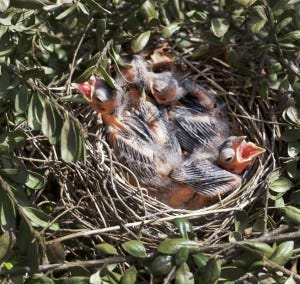 7. Encourage Nesting Sites
7. Encourage Nesting Sites
Unlike many other backyard birds, Cardinals will not use birdhouses or nesting boxes. In addition to enjoying dense plant life for shelter, they also prefer it for nesting. Grapevines, tall trees, and shrub thickets are ideal options for nest sites. Readily available nesting materials are also essential to encouraging long-term Cardinal nesting. Make sure that your yard features pine needles, small twigs, grass clippings, and other materials so that Cardinal visitors will build a nest nearby.
3 Things to Avoid
Adding appealing elements to your yard isn’t the only thing you can do to attract cardinals to your yard. There are also a few things you can avoid to make your property safer, ensuring many return visits by your cardinal friends.
1. Reflective surfaces. Cardinals are known to attack their reflections as a territory-protecting measure. Though this behavior isn’t generally fatal, it may cause beak damage as well as unnecessary stress. You can prevent this by eliminating the reflection of windows or mirrors near nesting and feeding areas. For windows, try using screens or bird netting to deter them. Cover car mirrors, when not in use, with opaque items such as plastic bags.
2. Harmful chemicals. Avoid using chemicals and poisons in the vicinity of your bird feeders and birdbaths. Insecticides, herbicides, and many fertilizers can contaminate your food and water sources. This can often be lethal to your Cardinals.
3. Predator-accessible feeding areas. First, if you have pets that go outdoors, you should do your best to keep them away from Cardinal feeding areas. In addition, you should avoid placing feeders or scattering seed near low shrubs and bushes, and anywhere else that predators may hide and easily attack them.
Do You Have Cardinals in Your Yard?
Do you have more questions, or want to share your own tips for attracting Northern Cardinals? Be sure to visit us on Facebook to share pictures and tell us your Cardinal stories. You can also subscribe to our e-newsletter to have exclusive product updates and articles delivered directly to your inbox.





